“Carbon atoms are about half a million times smaller than the average thickness of a human hair, but they can be a billion times larger in the cold and sparse gas. The outermost electron is then orbiting the nucleus at a much larger distance,” said Morabito. The outermost electron can be captured by an atom that is missing an electron. A spectral line will then be visible in the light spectrum. All spectral lines form the chemical fingerprint of an atom such as carbon.
Astronomers predicted in the 1970s that the carbon spectral line would be detectable outside our galaxy. This first observation took 40 years to be made. The line is hard to detect because it is too faint when the gas that is surrounding the atoms is too warm or too dense. The cold, sparse gas is present in starburst galaxies — galaxies in which stars form at a high rate. For this reason, the carbon spectral line is easier to detect in galaxies of this type.
Most radio telescopes observe at frequencies at which the carbon line cannot be detected. Other telescopes are not sensitive enough to detect the spectral lines of the carbon atoms at low frequencies. The LOFAR radio telescope that stretches from the northeast of the Netherlands across Europe is perfect for these kind of observations because of its frequency range and sensitivity. “LOFAR is an unique telescope. This telescope opens up a new window on the universe,” said Raymond Oonk from Leiden Observatory and ASTRON.
The carbon atoms are present in the heart of the starburst galaxy M82, where 10 times more stars are being born in the same period as in our Milky Way. The cold and sparse gas in this area impacts star formation and the evolution of M82. “Since the co-discovery of the hydrogen 21-cm line by Dutch, American, and Australian astronomers, we have been looking for a way to determine additional properties of the cold gas such as its temperature and density. It is fantastic that we now have found a way thanks to this carbon line. We can now collect more and better observations and compare them to predictions from theoretical models,” said Huub Röttgering from Leiden Observatory.










